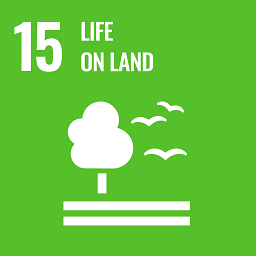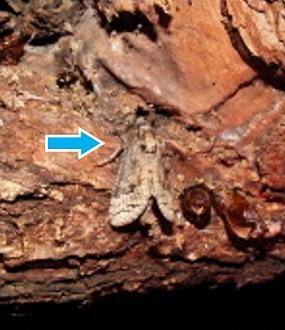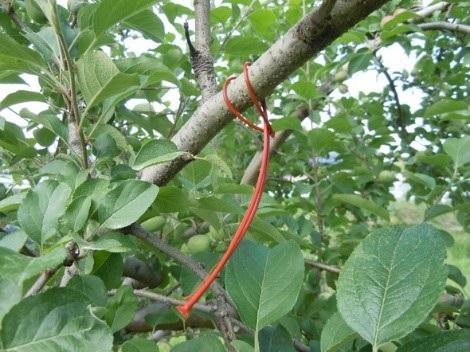Outcome Example of Bio-oriented Technology Research Advancement Institution
Issued on August 17, 2020


Control of moths with a sex pheromone agent
Have you ever heard of the word "sex pheromone"? In general, chemical substances released from female insects to attract male insects for mating are called sex pheromones. An attempt has been made to reduce the number of harmful moths by synthesizing the sex pheromone and spraying it around the farms to prevent the male and female moths from communicating and mating. Apple farms in Fukushima have achieved excellent results in controlling moths with a sex pheromone agent.
Reduces the number of moths with tubes wound around trees
An insect pest called Cossus insularis bores into on the trunks and branches of apple and pear trees in farms (Photo 1 by Tokushima Prefectural Agriculture, Forestry, and Fisheries Technology Support Center). Cossus insularis is one of the moth species. The larva of Cossus insularis (Photo 2 by Dr. Kiyoshi Nakamuta) invades into the tree trunk and branch and eats ligneous tissues. Certain apple trees, where the larva grows for 2-3 years, have gradually weakened and might progress into death.
To address this issue, fruit farms have made considerable efforts in taking measures, such as cutting down the affected trees and injecting pesticides. Against this ground, a more labor-saving synthesized sex pheromone agent has been developed. The farmers may control moths only by winding tubular dispensers around the trunks and branches of the trees in the fruit farms (Photo 3 by Fruit Tree Research Center, Fukushima Agricultural Technology Center). (100 to 150 tubes per 1,000 square meters).
After installing the dispensers, synthetic sex pheromone slowly spreads into the air and throughout the fruit farm. The male moth flies to aim the smell of sex pheromone released by the female moth for mating. However, the male moth may not locate the female moth in the air filled with the synthetic sex pheromone, failing to mate with the living female moth. This is why the reproductive rate and egg-laying rate of moths decrease, leading to gradually reduced offspring.
 |
 |
| Image 1:Adult of Cossus insularis | Image 2: A red worm (indicated by an arrow) is a larva. |

The effect of an insecticide is retained only for 1 to 2 weeks; accordingly, the farmers may miss spraying it at an appropriate time in some cases. However, the effect of the sex pheromone agent is retained for a few months, eliminating the concern about the failure to spray. This agent is characterized in that: 1) it is easy to install; 2) it has very low toxicity to the human body and livestock because it is a substance released by the moths in nature; 3) it eliminates the concern about the residual agent in products, such as apples and pears; and 4) capable of reducing the frequency of insecticide application, resulting in the conservation of beneficial organisms such as natural enemies.
Great achievement in Fukushima
Between 2011 and 2013, Chiba University, Fruit Tree Research Center(Fukushima Agricultural Technology Center) and others conducted a joint research project in apple farms in Fukushima. The ratio of the damaged trees to the total trees reduced to about 10% from 30% three years after the synthetic pheromone agent was applied. Similar results were obtained at the pear farms in Tokushima prefecture.
With the background of these research outcomes, one of the joint research members, Shin-Etsu Chemical Co., Ltd. submitted an application for the registration as "a control agent" and the agent was accredited under the product name "Bokutoukon®-H" in 2015 when a path for practical use was opened up. At present, damage by moths is no longer seen because of the installment of "Bokutoukon®-H " in Fukushima. The measure for preventing fruit tree damage from moths in Fukushima is an excellent successful case of early control of moths.
These research results won the award of Popularized Good Practice of "the Special Scheme Project on Advanced Research and Development for Next-Generation Technology" sponsored by the Ministry of Agriculture, Forestry and Fisheries of Japan (MAFF). In July 2019, a press briefing was held at MAFF.
Dr. Kiyoshi Nakamuta, a Grand Fellow at Chiba University, made the following speech. "Once larvae of moths have invaded into the trunk and branch of apple or pear trees, they cannot be controlled even by spraying any of existing insecticides. "Bokutoukon®-H " reduces the density of next-generation by disrupting the communication between male and female moths. It prevents them from mating and is not a fast-acting agent. However, it was demonstrated that when the agent is used over a wide area for several years, it will exhibit an excellent effect in reducing damage by moths."
Cossus insularis
Cossus insularis belongs to the the family Cossidae ,the order Lepidoptera. It has gray-brown wings, and the body length of an adult is 3 to 4 cm. Previously, Cossus insularis had been designated as a forest pest insect. In 2001, damage by Cossus insularis in the pear farms was first reported in Tokushima. Since then, the damage has been spread into several prefectures, including Akita, Fukushima (apple and Japanese pear), Miyagi, Chiba, and Saga (Japanese pear), centering on Tohoku District.
Project name
The special scheme project on advanced research and development for next-generation technology (Practical Technology Development Stage)
Project period
FY 2011 to 2013
Title
Development of complex technology for controlling "Cossus insularis," which affects the places of apple and pear production, by disturbing the male-female communication
Project research institute
Chiba University, Fruit Tree Research Center(Fukushima Agricultural Technology Center), and Shin-Etsu Chemical Co., Ltd., and others
